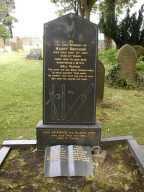“Harry the Umpire” (Harry Bagshaw, 1859-1927)A Biography of Harry Bagshaw, the Cricketer. Thousands of visitors are drawn to the village of Eyam by the poignant story of the plague and the sacrifices made by the villagers to halt the spread of the deadly disease. The former tailors cottage where it first broke out; the family graves of the victims; the Parish Church of St. Lawrence; the tomb of Catherine Mompesson, wife of the Rector who led the villagers in their brave fight against the plague; all of these are a must for the visitor to see. Many people miss another grave in the churchyard, which is of special note to the followers of cricket and those in search of unusual tombstones, that of a former sporting hero, Harry Bagshawe, who was the Dickie Bird of his day. Harry, christened Henry, Bagshaw was born at Foolow on September 1st 1859 and died at Crowden, near Glossop on 31st January 1927 aged 67. He first came to the attention of Derbyshire County Cricket Club in 1880, when he played for the Colts team, making his first-class debut in 1887. He is described as being a free-hitting batsman of well above the average; a medium paced bowler and hard working fielder in the slips. Batting left handed, but in other departments of the game he was right-handed. He became a stalwart of the team in the 1890's when he formed a successful opening partnership with L.G.Wright. In his career with Derbyshire he played in 123 matches, scoring 5413 runs at an average of 26.28, with a highest score of 127 not out against Yorkshire in 1895. In 1896 he scored a hundred before lunch, again against Yorkshire, at Derby. He took 73 wickets at 29.03 and held 26 catches. He also played in matches for M.C.C. and was professional for Barnsley where, in 1888 he scored 220 and took all 10 wickets in an innings against Wakefield in 1891. His fame grew after he retired from playing, when he became a first-class umpire. Until the end of 1924 he was, in the words of Wisden, the cricketers' bible, “an umpire in many great matches”. At the rear of Eyam Church is a tall headstone, which must be unique. At the apex is a hand with a finger pointing heavenward, below the lettering is a set of stumps, with the bails flying off and a bat that has clearly missed the ball, which has just hit the wicket! The inscription on the stone reads; who died aged 67 years. From 1888 to 1924 with Derbyshire and M.C.C. Well Played. For when that one great Scorer comes To write against your name He writes - not that you won or lost But how you played the game” Grantland Rice's oft-quoted poem is the perfect analogy for a cricketers life and death that is particularly apt as an epitaph for Harry Bagshaw. At his own request he was buried wearing his umpires' coat and with a cricket ball in one hand. The next time you visit the Plague Village, seek out this unique tombstone, which is well signposted in the churchyard, just beyond the Church Office, as the “Cricketers' Grave”. Go and pay homage to Harry Bagshaw, cricketer and umpire, who was left to play his last great innings a good fielders' throw away from the cricket pitch at Eyam, just two miles away from where he was born. This information was contributed by Alan Jacques in February 2004. |
|
